The penetration of virtual classroom teaching into German teaching is the presentation of teaching innovation in the information age. In this work, we explore the necessity of applying virtual classroom teaching in German classrooms and the effective strategies of German teaching innovation in virtual classrooms, to provide some suggestions for the reform of German teaching. First, the GPS trajectories are transformed into a sequence of hotspot regions using the spatiotemporal properties of GPS points. Then, a sequential pattern mining algorithm of asynchronous cycles with multiple minimum supports based on pattern growth is adopted, and the sequential patterns of asynchronous cycles are deeply recursively mined according to the multiple minimum supports. Experiments show that the proposed IoT-assisted teaching scheme can effectively integrate equipment resources, mine spatiotemporal information, and help students and teachers establish a new educational method of integrating space and land. Compared with the baseline, it can fully exploit the characteristics of German.
In recent years, the rapid development of virtual classrooms has gradually been widely used in various fields, and has gradually become popular in school education, especially in the field of foreign language teaching [1, 2]. Most schools and educational institutions are exploring the application of virtual classrooms in German teaching and are constantly trying and innovating [3]. At present, there are relatively more research on English teaching in virtual classroom education in my country, but less research on the application of virtual classrooms to German teaching. Therefore, in the current educational environment, schools should adapt to social development, meet the learning needs of German majors, and constantly explore the teaching of German in virtual classrooms [4, 5]. Virtual classrooms only need one device to teach. With the development of the information age, students can learn German at home through virtual classrooms, and when they encounter learning problems, teachers can help students through virtual classrooms in a timely manner, which is conducive to mobilization. Students’ initiative in learning German [6, 7]. The virtual classroom has a high degree of freedom and substitution. When students learn German through the virtual classroom, the students can give full play to their German ability in the current environment, and the students’ sense of achievement in learning German will gradually strengthen, mobilizing students Interest in teaching German [8]. When students integrate into the teaching environment set by the virtual classroom, it can effectively improve the time of students learning German, and also strengthen students’ learning outcomes [9]. In the virtual classroom, teachers can interact with students to gain an in-depth understanding of whether students understand the German knowledge they are learning, which helps to optimize the teacher-student relationship.
The characteristics of IoT users are one of the basic foundations of IoT personalized application design. IoT applications often involve the spatiotemporal characteristics of users, and the user’s spatiotemporal movement patterns are the most direct manifestations of spatiotemporal characteristics. The movement mode can reflect the user’s hobbies, activity rules, experience, and other characteristics [10, 11]. How to discover the time-sensitive and space-sensitive user characteristics to support the personalized application of the Internet of Things is a key problem that needs to be solved urgently [12]. Aiming at this problem, this paper proposes a spatiotemporal feature mining algorithm for IoT users to discover their hidden spatiotemporal motion patterns from their GPS trajectories [13, 14].
The innovations of this method are summarized as follows:
We propose a user GPS trajectory preprocessing method. On the basis of considering the time and space characteristics of GPS points, the hidden hotspot sequence is mined.
The asynchronous periodic sequence pattern mining model of hotspot sequence is proposed to describe those frequent and asynchronous periodic hotspot sequences.
We propose a sequential pattern mining algorithm for asynchronous periods with multi-minimum support based on pattern growth is used to discover the sequential patterns of asynchronous periods, that is, the spatiotemporal motion characteristics of users.
The proposed method is verified and evaluated with real and simulated data sets.
Figure 1 is the main parameters describing the mouth shape, including: mouth opening width, intraoral mouth opening, extraoral mouth opening, facial drumming, etc. By comparing these parameters, the standard mouth shape numbers in English pronunciation can be obtained information and write corresponding software to make it have error correction function. Figure 2 is the main technical parameters of English pronunciation, mainly including the frequency, intonation, amplitude, speed of speech and other main parameters, these parameters are used to obtain the technical indicators of English pronunciation.


Figure 3 is a schematic diagram of the composition and working principle of the interactive teaching system of the Internet of Things. The role of the image sensor is to take the learner’s mouth shape into the system and compare it with the stored standard mouth shape. Speech sensors are mainly used for frequency, intonation, and speech analysis during pronunciation. The system also includes commonly used learner PCs, local area network control center, system image and voice processing software, etc [15]. The local area network and local area network are connected by optical fiber.
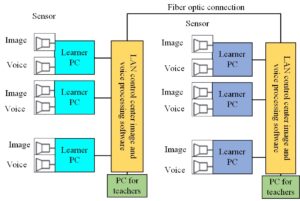
In many applications, the periodicity of the sequence is often not perfect and accurate, and there may be noise interference between the periodic segments of the sequence. The sequential pattern mining of synchronous periods can only identify the noise of “missing sequence” but cannot identify the noise of “sequence offset”. Sequence shifts caused by noise insertion can cause many valuable sequence patterns to go undetected. “System behavior” often recurs over a period and then may change or disappear, resulting in sequential patterns that may appear periodic in parts of the database [16, 17].
In response to the above problems, this paper proposes an asynchronous periodic sequential pattern mining model and finds that the time symbolic sequence database exhibits periodic sequential patterns in certain time ranges, and can tolerate a certain degree of noise interference. The core idea of the model is briefly described as follows: to determine whether a sequence is a sequence pattern with a potential asynchronous cycle, first, the sequence needs to occur continuously within a certain time range, which reflects the trend of the sequence with significant periodicity [18]; then, examine the time intervals between the time ranges in which these sequences occur periodically and continuously to determine whether these time intervals are “random noise” or “changes in system behavior”; finally, the time ranges in which the sequence periodically occurs continuously, subject to noise the time frame that is concatenated as the largest sequence period occurs. Specifically, the sequence pattern of the asynchronous cycle and its mining model are defined as follows: Sequence pattern of the asynchronous cycle. As shown in Figure 4 that a sequence \(a\) is a sequence pattern of an asynchronous cycle of the symbolic database TDB of time, if there is at least one valid containing fragment queue associated with \(a\) in the TDB, the period associated with that queue is cycle of the sequence pattern \(a\) of the asynchronous cycle.
It is not difficult to find that the sequence pattern of an asynchronous cycle may have multiple cycles, and each cycle may also correspond to multiple valid containing fragment queues. Define a sequential pattern mining model for 13 asynchronous cycles. Under the premise of specifying minimum support, maximum interval factor, minimum repetition count, and maximum period, sequential pattern mining of asynchronous periods is to discover the sequential patterns of all asynchronous periods in the symbol database of time and their corresponding valid containing fragment queues.
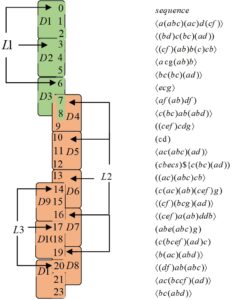
To greatly compress the search space of asynchronous periodic sequential pattern mining, the single minimum support asynchronous periodic sequential pattern mining model exploits the closed-down property. As shown in Figure 5, the P-Preisman algorithm first splits the database according to the minimum support vector and generates a series of sub-databases that are mined with a single minimum support. Each split is based on a frequent item, which is called a key item, and the single minimum support used to mine the sub-data is the minimum support of the key item [19, 20].
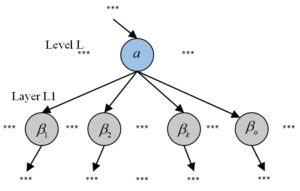
To mine a subset of sequential patterns of asynchronous cycles, one can construct a corresponding database of prefix projections and first mine each prefix projection database deeply recursively.
The dataset used in this experiment is the GPS trajectory data of four users in the Ge-olive dataset of Microsoft Research Asia for three years (April 2020 to December 2023). A GPS track in the dataset is a sequence of GPS points arranged in ascending time order, and each GPS point records longitude, latitude, altitude, date, and time. In the dataset, user 120 recorded 2135 GPS tracks, user 141 recorded 1343 GPS tracks, user 060 recorded 723 GPS tracks, and user 060 recorded 621 GPS tracks [21].
In this paper, the distance length and time length of the GPS trajectories of these four users are counted, as shown in Figure 6, and the statistical results of the time length are shown in Figure 7. Statistics show that users often only remember Several hours of GPS trajectories were recorded, and the time length of most GPS trajectories was distributed between 1 and 2 hours, which was relatively sparse. The transformation steps of GPS trajectories include denoising, stop point and switch point detection, stop point and switch clustering, stop point and switch point replacement. In the denoising process, the upper thresholds for setting the velocity and acceleration are set to 35 m/s and 10 m/s, respectively. In the staying point detection algorithm, the time threshold is set to 15min, and the distance threshold is set to 150m, that is, if the user hovers for more than 15min within the distance of 150m [22, 23], A stop point will be created. In this paper, the OP-TICS algorithm is used to cluster the user’s staying points and switching points. According to the GPS trajectory preprocessing method proposed in this paper, the GPS trajectories of 4 users are processed, and the statistical results after transformation are shown in Table 1.
| User | Number of dwell points / switching points | Number of clusters | Number of sequences | Average sequence length | Average number of items in the series |
| 061 | 132 | 434 | 1.7 | 1.22 | |
| 122 | 625 | 996 | 1.58 | 1.17 | |
| 135 | 321 | 13 | 751.38 | 1.11 | |
| 142 | 1.284 | 33 | 312 | 2.38 | 1.69 |

The AP-Preisman algorithm is used to perform asynchronous periodic sequence pattern mining on the hotspot sequence of user 141 respectively. Figure 7 shows the length distribution of the sequence pattern of asynchronous cycles under different minimum support conditions. When the minimum support is 1%, many meaningless sequential patterns are generated, and thereafter, as the minimum support increases, increases, the number of sequential patterns decreases drastically. When the minimum support is 4%, there are only 3 patterns of length 1. The number of sequence patterns of length 1 is the largest, because the temporal length of the user GPS trajectory is short, which is not sufficient to generate longer sequence patterns [24, 25].
Figure 8 shows the cycle length distribution of sequence patterns under different minimum support conditions. When the minimum support is not less than 2%, the period lengths of most sequence patterns are distributed between 1 and 14 days.
Figure 9 shows the length distribution of the effective containing fragment queue under different minimum support conditions. The length of the effective containing fragment queue refers to the number of effective containing fragments it contains. When the minimum support is not less than 2%, the lengths of most valid containing fragment queues are distributed between 1 and 3 [18].
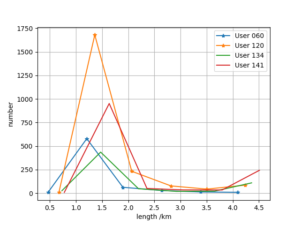


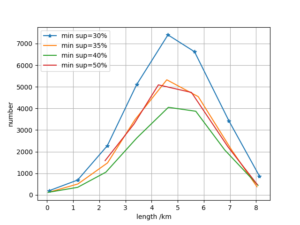
Using the simulation data set to generate the algorithm, a simulation data set is obtained, and the parameter values of the algorithm are shown in Table 2.
| Parameter | Meaning | Value |
|---|---|---|
| N | Time scale of symbol sequence data | 5000 |
| S | Total items | 300 |
| High | Proportion of highly frequent items | 1/3(60%) |
| Medium | Number and proportion of moderately frequent projects | 1/3(30%) |
| Low | Proportion of low frequent projects | 1/3(10%) |
| C | Number of possible asynchronous cycle sequence patterns | 6 |
| P | Average period length of sequence pattern | 6 |
| T | Number of item sets averaged by the sequence pattern | 9 |
| I | Average number of items in the item set | 3 |
| R | Average repeat count of containing fragments | 26 |
| d | Average value of the ratio of random interference to period | 9 |
Figure 10 shows the length distribution of the asynchronous periodic sequence mode for different minimum support conditions. The experimental results show that the number of sequential patterns increases gradually as the minimum support decreases. When the minimum support for high-frequency and mid-frequency items is set high (5%) and the minimum support for low-frequency items is set very low (1%), a large number of sequence patterns of length 1 or 2 appear, indicating that even if only focus on Low-frequency items, if the minimum support is too low, can also show a lot of meaningless sequential patterns. Under other minimum support conditions, the number of sequential patterns increases sharply as the length of the sequential pattern increases, and when the length of the sequential pattern is 5, the number of sequential patterns decreases to a maximum value, and then increases with the sequential pattern length. A lower total number of items results in a lower number of short-length sequential patterns. As the schema grows, more and more items can expand to short schemas, resulting in an explosion in the number of schemas.
This paper discusses the effective strategies of German teaching innovation in virtual classrooms and proposes an algorithm for mining the spatiotemporal features of IoT users to discover hidden user movement patterns from GPS trajectories. The experimental results demonstrate the effectiveness and accuracy of the algorithm. In the future, the semantic information of the map will be introduced into the spatiotemporal feature mining algorithm, so as to obtain the spatiotemporal features of IoT users more comprehensively and accurately. Finally, we analyze and improve the virtual classroom technology, the combination of virtual classroom and traditional classroom, and the construction of a perfect virtual classroom management model and summarize the teaching methods suitable for students to learn German, thereby improving the overall level of students’ German.
This work was supported by Shandong Provincial Social Science Planning Research Project “A Study on Cognitive Mechanism of German-Chinese Sight Translation process of Student Interpreters” (Project No. 20DYYJ06).
The author declares no conflict of interests.